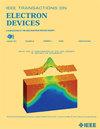Mechanism of Heavy Ion-Induced Leakage Current Increase in Normally-OFF p-GaN Gate HEMTs
IF 3.2
2区 工程技术
Q2 ENGINEERING, ELECTRICAL & ELECTRONIC
引用次数: 0
Abstract
The heavy ion-induced leakage current increase is reported for the 650-V p-gallium nitride (GaN) gate HEMTs. The degradation of leakage current increase in GaN HEMTs caused by heavy ions is related to the linear energy transfer (LET) value of the heavy ions and the bias voltage. The increased leakage current is only observed under Ta ion irradiation with an LET value of 60.5 MeV正常关断p-GaN栅极hemt中重离子诱导漏电流增大的机理
报道了650 v p-氮化镓(GaN)栅极hemt的重离子诱导漏电流增加。重离子引起的氮化镓hemt漏电流增加的退化与重离子的线性能量转移值和偏置电压有关。泄漏电流只有在LET值为60.5 MeV $\cdot $ cm2/mg的Ta离子辐照下才有增加,而在LET值为20.0 MeV $\cdot $ cm2/mg的Kr离子辐照下没有增加。此外,较高的偏置电压会导致泄漏电流增加的更明显的退化。当器件偏置在100v时,漏极和源极之间存在重离子诱发的漏路。然而,当电压增加到200v时,除了漏极与源极之间的漏电外,漏极与栅极之间还形成漏电通路。在辐照器件中观察到重离子引起的场板损伤和形态变化,这可能是导致泄漏退化的原因。通过TCAD仿真验证了损伤机理。
本文章由计算机程序翻译,如有差异,请以英文原文为准。
求助全文
约1分钟内获得全文
求助全文
来源期刊

IEEE Transactions on Electron Devices
工程技术-工程:电子与电气
CiteScore
5.80
自引率
16.10%
发文量
937
审稿时长
3.8 months
期刊介绍:
IEEE Transactions on Electron Devices publishes original and significant contributions relating to the theory, modeling, design, performance and reliability of electron and ion integrated circuit devices and interconnects, involving insulators, metals, organic materials, micro-plasmas, semiconductors, quantum-effect structures, vacuum devices, and emerging materials with applications in bioelectronics, biomedical electronics, computation, communications, displays, microelectromechanics, imaging, micro-actuators, nanoelectronics, optoelectronics, photovoltaics, power ICs and micro-sensors. Tutorial and review papers on these subjects are also published and occasional special issues appear to present a collection of papers which treat particular areas in more depth and breadth.
 求助内容:
求助内容: 应助结果提醒方式:
应助结果提醒方式:


